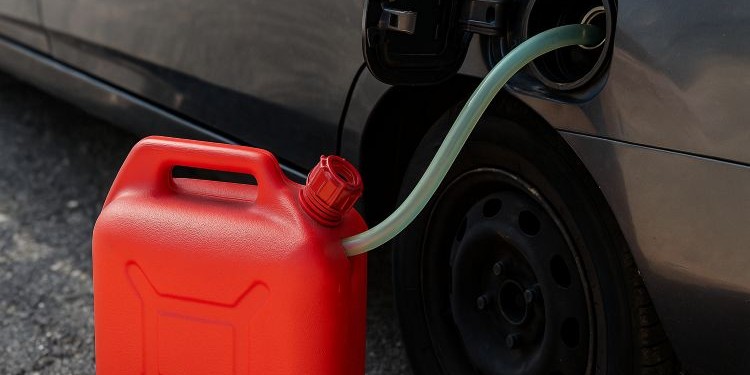How to Siphon Gas from a Car with Anti-Siphon

Let’s get something straight: if you’re looking up how to siphon gas from a car with anti-siphon, you’re not just curious. You’re preparing. And in a world where the grid can fail overnight, gas stations can run dry in hours, and supply chains can collapse in a heartbeat, knowing how to get fuel when you need it might be the difference between escape and entrapment.
Now, modern vehicles are designed to stop you. Anti-siphon technology — little metal flaps, spring-loaded traps, mesh filters shoved inside filler necks — all engineered not for your safety, but to make sure you stay dependent on the pumps, the stations, and ultimately the system. Because if you can’t access your own survival fuel, you’re easier to control.
But here’s the truth: with a little know-how, anti-siphon doesn’t mean “impossible.” It just means “harder to drain the tank.” And harder is exactly what you should be training for now, while the shelves are still stocked and the lights are still on.
In a crisis, the people who froze up, who hesitated, who never learned how to adapt? They’ll be the ones begging at a closed station. The ones who already practiced? They’ll be driving away with a tank full, not a stomach full of regret.
The Old Way Doesn’t Work Anymore
Forget Hollywood. The days of jamming a hose down a filler neck and sucking until you taste unleaded are gone. That trick only works on pre-’90s cars and the occasional old truck. Anti-siphon designs introduced after that block hoses, pinch tubes, or redirect you into a dead end. If you try the old method on a modern car, you’ll waste time and maybe damage the filler neck beyond use.
And if you think damaging the filler neck doesn’t matter — think again. Once it bends or warps, you’re not just out of luck for siphoning, you may also trigger sensors or alarms in newer vehicles. Some are designed to lock you out entirely if tampered with, leaving you stranded. The system doesn’t just want to block you, it wants to punish you for even trying.
Related: How To Siphon Gas From A Boat Tank
That’s why clinging to old tricks is dangerous. Preppers who don’t adapt their skills to modern technology will find themselves at the mercy of outdated methods. And mercy doesn’t exist in a world where the shelves are bare. Knowledge evolves, and so must you.
Workarounds for Anti-Siphon Systems
So how do you actually get around these so-called “fail-safes”?
1. The Pump Assist Method
Instead of relying on gravity, you create suction using a hand pump or squeeze bulb. Flexible tubing + a manual pump lets you slip past partial barriers and draw fuel into a container without risking a mouthful of gas. Cheap, portable, and far safer than sucking.
A good hand pump can also pull fuel faster than gravity alone, which means less time spent exposed, less chance of being noticed, and less wasted energy. In a crisis, speed is survival. Think of it as a low-tech tool that outsmarts high-tech roadblocks.
Some pumps are even designed to switch directions, letting you transfer gas back into another vehicle or generator. That versatility turns one simple tool into a lifeline for both mobility and barter.
2. Access the Fuel Line
Every car has a fuel line that runs from the tank to the engine. Disconnecting it (usually near the fuel filter or along the underside of the car) and attaching your own tubing gives you direct access to the tank — bypassing filler neck traps altogether. Messy, yes. Effective? Absolutely.
This method requires a little more mechanical awareness, but it’s straightforward once you learn the basics. Carry gloves, a wrench, and tubing, and you can draw directly from the tank without ever touching the filler neck.
And here’s the kicker: if you practice now, you’ll know exactly where that line is on your own vehicle. In a true emergency, fumbling around under the chassis in the dark could cost you more than time — it could cost you your life.
3. Fuel Tank Drain Plug
Some vehicles still have a drain plug at the bottom of the tank. If it’s there, it’s the fastest route. Loosen the plug, catch the gas in a container, tighten it back up. The downside: not every car has one, and it’s easier to spot (and smell) what you’re doing.
Drain plugs are a rare gift in modern cars, but if you know which makes and models still include them, you’ve got an advantage. It’s worth studying now so you can identify them later.
The drawback? Gas will flow fast and uncontrolled. If you’re not prepared with the right container, you’ll waste more fuel than you save. Preparation, again, is the difference between resourcefulness and disaster.
4. Specialty Anti-Siphon Tools
Believe it or not, mechanics already solved this problem. Flexible, stiffened siphon tubes designed to snake past anti-siphon traps exist — you won’t find them at Walmart, but survival suppliers, auto shops, and certain corners of the internet still carry them.
These tools aren’t advertised to preppers — they’re marketed for “maintenance.” But the truth is, once you own one, you’ve neutralized the entire anti-siphon problem. It’s a $30 piece of plastic standing between you and total fuel independence.
And here’s the dark reality: once the crisis hits, these tools will vanish. Shelves will be stripped clean by the few who even know they exist. Which means the time to get them is now — while the lights are still on.
Why This Knowledge Matters
This isn’t about theft. This is about survival. If supply chains collapse tomorrow, gas stations will be empty in hours. Trucks stop rolling, cities grind to a halt, and suddenly your car is nothing but a metal coffin unless you know how to keep it fueled. Fuel isn’t just mobility — it’s backup power for generators, heat in the dead of winter, and a bargaining chip when barter becomes the new economy.
History proves it: in every collapse, fuel is one of the first currencies to emerge. Those who control energy control movement, heat, and trade. Those who don’t? They’re stuck in place, at the mercy of whoever does.
And while officials will scream “It’s illegal!” or “It’s dangerous!” — ask yourself this: when the shelves are bare and the lights go out, will legality keep your family warm? Will bureaucracy keep your generator running? Or will skill and preparation?
The narrative of “danger” is designed to keep you scared of independence. Because an independent population isn’t compliant. That’s why this knowledge is buried, stigmatized, and dismissed. But those who prepare anyway are the ones who survive the storm.
Final Thoughts
Learning how to siphon gas from a car with anti-siphon isn’t about cutting corners. It’s about cutting the strings of dependency. The system doesn’t want you to know this — that’s why they bury the knowledge, redesign cars, and criminalize self-reliance. But when the next blackout, shortage, or manufactured “crisis” hits, the ones who prepared won’t be stranded.
You’ll be moving. You’ll be trading. You’ll be surviving.
And here’s the real kicker: when everyone else is panicking, when their cars are dead and their houses are cold, you’ll have something they don’t — options. That’s the ultimate currency in chaos. Options buy you time, freedom, and leverage. Options keep you alive.
So don’t wait until you’re desperate to figure this out. Learn now. Practice now. Because once the lights go out, it’s already too late.
You may also like:
 How to Siphon Gas from a Motorcycle
How to Siphon Gas from a Motorcycle
6 Easy Ways to Siphon Gas in A Survival Situation
How To Recondition Old Gasoline
7 Survival Uses for Expired Gas
Read the full article here









